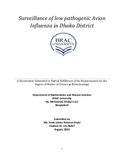Surveillance of low pathogenic avian influenza in Dhaka District
Abstract
This present research was under taken with a view to investigate the epidemiological and molecular study of Low pathogenic Avian Influenza (LPAI). For this purpose samples were collected from 800 clinically healthy birds of which 500 were migratory birds, 70 were ducks, 190 were commercial poultry and 40 from backyard poultry. For the migratory bird environmental samples (stool) were collected and for the rest of the birds cloacal swab were collected. Samples were inoculated into chicken embryo and checked for embryo death. Allantoic fluid from the dead embryo was collected and hemagglutination test was done. HA test positive samples were subjected to RRT PCR for matrix gene of avian influenza to confirm influenza A. The influenza A positive samples for matrix gene were sent to FAO & OIE central laboratory for the detection of H5, H7, H9 gene of AI.
Out of 500 migratory bird samples 20 were found HA positive in which 8 was found influenza A positive (7 was H9 and one was H5). Out of 190 live bird market samples 12 were found HA positive in which 4 were found influenza A positive all of which were H9 gene positive. Out of 70 native duck samples 4 was found HA positive but none was influenza A positive. Out of 40 backyard poultry samples 2 were HA positive and none was influenza A positive.
From the above study it was concluded that low pathogenic avian influenza is present in clinical healthy poultry and migratory bird. It also has shown one isolated case of highly pathogenic avian influenza. This indicates future threat of epidemic of highly pathogenic avian influenza in birds of Bangladesh which might be transmissible to human being. This risk of disease transmission is of significant public health concern.

